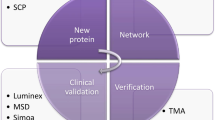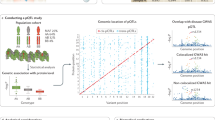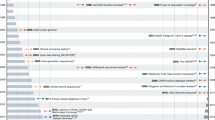Abstract
Completion of the Human Genome Project has been rapidly followed by the emergence of high-throughput technologies that combine automation, miniaturization, and many other strategies and tools to enable systematic surveys of genome composition and gene expression. Of particular relevance to the prevention and management of disease are technologies such as high-throughput DNA genotyping, microarray-based gene-expression profiling, and mass spectrometry-facilitated protein profiling—platforms that collectively support the comprehensive analysis of DNA sequence variants across the genome and the global gene and protein expression changes that distinguish health from disease. Now used extensively in all facets of biomedical investigation, genomic and proteomic tools are already beginning to pinpoint molecular variants that influence risk and outcome in common diseases, and to thereby inform and direct development of novel molecular biomarkers and drug targets. As evidenced by recent advances in DNA sequencing methods, continued improvements in the scope, power, and cost efficiency of genomic and proteomic technologies should ensure their capacity to provide the scale and depth of knowledge required for translating genome sequence information into major medical impact.
Key Points
-
Genomic sciences encapsulate a group of high-throughput technologies that enable the simultaneous systematic analysis of whole genomes or proteomes
-
Genomics research has identified single nucleotide polymorphisms as the major source of genome variation and provided powerful technology platforms to facilitate high-throughput scoring of these variants and their use in genome-wide association analysis
-
Microarrays are used in many facets of genomics research, enabling, for example, the simultaneous interrogation of hundreds of thousands of single nucleotide polymorphisms or expressed transcripts to be carried out
-
Advances in mass spectrometry instrumentation, automation and analytic methods have made mass spectrometry one of the most powerful platforms for high-throughput protein analysis
-
Continued improvements in genomic and proteomic technologies will increase their power, efficiency and, ultimately, clinical impact
This is a preview of subscription content, access via your institution
Access options
Subscribe to this journal
Receive 12 print issues and online access
$209.00 per year
only $17.42 per issue
Buy this article
- Purchase on Springer Link
- Instant access to full article PDF
Prices may be subject to local taxes which are calculated during checkout



Similar content being viewed by others
References
Begovich AB et al. (2004) A missense single-nucleotide polymorphism in a gene encoding a protein tyrosine phosphatase (PTPN22) is associated with rheumatoid arthritis. Am J Hum Genet 75: 330–337
Prokunina L et al. (2002) A regulatory polymorphism in PDCD1 is associated with susceptibility to systemic lupus erythematosus in humans. Nat Genet 32: 666–669
Cargill M et al. (2007) A large-scale genetic association study confirms IL12B and leads to the identification of IL23R as psoriasis-risk genes. Am J Hum Genet 80: 273–290
Ogura Y et al. (2001) A frameshift mutation in NOD2 associated with susceptibility to Crohn's disease. Nature 411: 603–606
Hugot JP et al. (2001) Association of NOD2 leucine-rich repeat variants with susceptibility to Crohn's disease. Nature 411: 599–603
Risch N and Merikangas K (1996) The future of genetic studies of complex human diseases. Science 273: 1516–1517
Kuhn RM et al. (2007) The UCSC genome browser database: update 2007. Nucleic Acids Res 35 (database issue): D668–D673
Kyogoku C et al. (2004) Genetic association of the R620W polymorphism of protein tyrosine phosphatase PTPN22 with human SLE. Am J Hum Genet 75: 504–507
Viken MK et al. (2005) Association analysis of the 1858C>T polymorphism in the PTPN22 gene in juvenile idiopathic arthritis and other autoimmune diseases. Genes Immun 6: 271–273
Criswell LA et al. (2005) Analysis of families in the multiple autoimmune disease genetics consortium (MADGC) collection: the PTPN22 620W allele associates with multiple autoimmune phenotypes. Am J Hum Genet 76: 561–571
Ragoussis J and Elvidge G (2006) Affymetrix GeneChip system: moving from research to the clinic. Expert Rev Mol Diagn 6: 145–152
Gunderson KL et al. (2005) A genome-wide scalable SNP genotyping assay using microarray technology. Nat Genet 37: 549–554
The International HapMap Consortium (2003) The International HapMap Project. Nature 426: 789–796
John S et al. (2004) Whole-genome scan, in a complex disease, using 11,245 single-nucleotide polymorphisms: comparison with microsatellites. Am J Hum Gen 75: 54–64
Amos CI et al. (2006) High-density SNP analysis of 642 Caucasian families with rheumatoid arthritis identifies two new linkage regions on 11p12 and 2q33. Genes Immun 7: 277–286
Ennis S et al. (2007) Fine scale linkage disequilibrium mapping of age related macular degeneration in the complement factor H gene region. Br J Ophthalmol 91: 966–970
Smyth DJ et al. (2006) A genome-wide association study of nonsynonymous SNPs identifies a type 1 diabetes locus in the interferon-induced helicase (IFIH1) region. Nat Genet 38: 617–619
Duerr RH et al. (2006) A genome-wide association study identified IL23R as an inflammatory bowel disease gene. Science 314: 1461–1463
Kallioniemi A et al. (1992) Comparative genomic hybridization for molecular cytogenetic analysis of solid tumors. Science 258: 818–821
Komura D et al. (2006) Genome-wide detection of human copy number variations using high-density DNA oligonucleotide arrays. Genome Res 16: 1575–1584
Aitman TJ et al. (2006) Copy number polymorphism in Fcgr3 predisposes to glomerulonephritis in rats and humans. Nature 439: 851–855
Wilson GM et al. (2006) DNA copy-number analysis in bipolar disorder and schizophrenia reveals aberrations in genes involved in glutamate signaling. Hum Mol Genet 15: 743–749
Bennett ST et al. (2005) Toward the 1,000 dollars human genome. Pharmacogenomics 6: 373–382
Bentley DR (2006) Whole-genome re-sequencing. Curr Opin Genet Dev 16: 545–552
Leamon JH et al. (2003) A massively parallel PicoTiterPlate based platform for discrete picoliter-scale polymerase chain reactions. Electrophoresis 24: 3769–3777
Wicker T et al. (2006) 454 sequencing put to the test using the complex genome of barley. BMC Genomics 7: 275
Jares P (2006) DNA microarray applications in functional genomics. Ultrastruct Pathol 30: 209–219
van der Pouw Kraan TC et al. (2003) Discovery of distinctive gene expression profiles in rheumatoid synovium using cDNA microarray technology: evidence for the existence of multiple pathways of tissue destruction and repair. Genes Immun 4: 187–196
Batliwalla FM et al. (2005) Microarray analyses of peripheral blood cells identifies unique gene expression signature in psoriatic arthritis. Mol Med 11: 21–29
Baechler EC et al. (2003) Interferon-inducible gene expression signatures in peripheral blood cells of patients with severe lupus. Proc Natl Acad Sci USA 100: 2610–2615
Pascual V et al. (2005) Role of interleukin-1 (IL-1) in the pathogenesis of systemic onset juvenile idiopathic arthritis and clinical response to IL-1 blockade. J Exp Med 201: 1479–1486
Lequerre T et al. (2006) Gene profiling in white blood cells predicts infliximab responsiveness in rheumatoid arthritis. Arthritis Res Ther 8: R105
Ioannidis JP (2005) Microarrays and molecular research: noise discovery? Lancet 365: 454–455
Arya M et al. (2005) Basic principles of real-time quantitative PCR. Expert Rev Mol Diagn 5: 209–219
Roe MR and Griffin TJ (2006) Gel-free mass spectrometry-based high throughput proteomics: tools for studying biological response of proteins and proteomes. Proteomics 6: 4678–4687
Hueber W and Robinson WH (2006) Proteomic biomarkers for autoimmune disease. Proteomics 6: 4100–4105
Wysocki VH et al. (2005) Mass spectrometry of peptides and proteins. Methods 35: 211–222
Washburn MP et al. (2001) Large-scale analysis of the yeast proteome by multidimensional protein identification technology. Nat Biotechnol 19: 242–247
Merchant M and Weinberger SR (2000) Recent advancements in surface-enhanced laser desorption/ionization-time of flight-mass spectrometry. Electrophoresis 21: 1164–1167
Tilleman K et al. (2005) Chronically inflamed synovium from spondyloarthropathy and rheumatoid arthritis investigated by protein expression profiling followed by tandem mass spectrometry. Proteomics 5: 2247–2257
de Seny D et al. (2005) Discovery of new rheumatoid arthritis biomarkers using the surface-enhanced laser desorption/ionization time-of-flight mass spectrometry ProteinChip approach. Arthritis Rheum 52: 3801–3812
Wiese S et al. (2007) Protein labeling by iTRAQ: a new tool for quantitative mass spectrometry in proteome research. Proteomics 7: 340–350
Kopf E et al. (2005) Panorama Ab microarray cell signaling kit: a unique tool for protein expression analysis. Proteomics 5: 2412–2416
Qin S et al. (2006) Development of a “reverse capture” autoantibody microarray for studies of antigen-autoantibody profiling. Proteomics 6: 3199–3209
MacBeath G and Schreiber SL (2000) Printing proteins as microarrays for high-throughput function determination. Science 289: 1760–1763
Calvo KR et al. (2005) Clinical proteomics: from biomarker discovery and cell signaling profiles to individualized personal therapy. Biosci Rep 25: 107–125
Hueber W et al. (2005) Antigen microarray profiling of autoantibodies in rheumatoid arthritis. Arthritis Rheum 52: 2645–2655
Li QZ et al. (2007) Protein array autoantibody profiles for insights into systemic lupus erythematosus and incomplete lupus syndromes. Clin Exp Immunol 147: 60–70
Matsuzaki H et al. (2004) Genotyping over 100,000 SNPs on a pair of oligonucleotide arrays. Nat Methods 1: 109–111
Hardenbol P et al. (2003) Multiplexed genotyping with sequence-tagged molecular inversion probes. Nat Biotechnol 21: 673–678
Jurinke C et al. (2001) Automated genotyping using the DNA MassArray technology. Methods Mil Biol 170: 103–116
Bell PA et al. (2002) SNPstream UHT: ultra-high throughput SNP genotyping for pharmacogenomics and drug discovery. Biotechniques (Suppl): 70–72, 74, 76–77
Tobler AR et al. (2005) The SNPlex genotyping system: a flexible and scalable platform for SNP genotyping. J Biomol Technol 16: 398–406
Livak KJ et al. (1995) Oligonucleotides with fluorescent dyes at opposite ends provide a quenched probe system useful for detecting PCR product and nucleic acid hybridization. PCR Methods Appl 4: 357–362
Makridakis NM and Reichardt JK (2001) Multiplex automated primer extension analysis: simultaneous genotyping of several polymorphisms. Biotechniques 31: 1374–1380
Acknowledgements
This work was supported by grants from the Ontario Research Development and Challenge Fund and the Canadian Institutes for Health Research. E Walker is supported by a McLaughlin Centre for Molecular Medicine (MCMM) fellowship award and K Siminovitch is an MCMM Scientist and holder of a Canada Research Chair.
Author information
Authors and Affiliations
Corresponding author
Ethics declarations
Competing interests
The authors declare no competing financial interests.
Supplementary information
Supplementary Figures 1
Genotyping single nucleotide polymorphisms by MALDI mass spectrometry. DNA templates for mass spectrometric analysis are prepared from genomic DNA from test samples using PCR to amplify short DNA fragments (~100 bp) that contain the target sequence. A primer annealing immediately upstream of the SNP on the target sequence is used with terminator deoxynucleotides and DNA polymerase to drive a primer extension reaction that creates amplified product representing one or the other of the SNP alleles. The amplified extension products are spotted onto chips and subjected to MALDI-TOF mass spectrometry. The allele-specific products differ in mass and generate distinct mass spectra that are interpreted using allele-calling software to assign SNP genotype. Abbreviations: MALDI-TOF, matrix-assisted laser desorption/ionization time-of-flight; PCR, polymerase chain reaction; SNP, single-nucleotide polymorphism. (JPG 375 kb)
Supplementary Figures 2
Schematic illustration of an ultra high-throughput sequencing strategy (454 Pyrosequencing). (A) Sequencing strategy. DNA templates are first fragmented and the fragments clonally amplified on beads within a microreactor formed by an emulsion of oil and water. (B) Sequencing reactions are performed in a picotitre plate, such that each plate carries about 1.6 million beads. dNTPs are flowed individually and sequentially across the plate in a fixed order. (C) Pyrosequencing chemistry. Incorporation of each dNTP results in the release of a pyrophosphate molecule. The pyrophosphate and adenosine 5’ phosphosulfate molecules are then converted by the sulfurylase enzyme to ATP, which provides energy for luciferase activation and light emission in parallel with single base addition. Abbreviations: ATP, adenosine triphosphate; dNTP, deoxynucleotide triphosphate; PPi, pyrophosphate. (PDF 599 kb)
Supplementary Figures 3
Mass spectrometry-mediated expression profiling. Samples are collected from affected individuals and controls and the proteins extracted, digested into peptide fragments, and then analyzed using two-dimensional high-performance liquid chromatography to separate the peptides according to charge and size. The separated peptides are directly subjected to mass spectrometric analysis using electrospray ionization or MALDI and tandem (MS/MS) mass spectrometry. Mass spectra are generated and database search programs used to identify the peptide components and proteins in each sample and the protein expression patterns that differ between disease and healthy states. Abbreviation: MALDI, matrix-assisted laser desorption/ionization. (JPG 96 kb)
Rights and permissions
About this article
Cite this article
Walker, E., Siminovitch, K. Primer: genomic and proteomic tools for the molecular dissection of disease. Nat Rev Rheumatol 3, 580–589 (2007). https://doi.org/10.1038/ncprheum0595
Received:
Accepted:
Issue Date:
DOI: https://doi.org/10.1038/ncprheum0595
This article is cited by
-
PATCHED-ONE or SMOOTHENED Gene Mutations Are Infrequent in Chondrosarcoma
Clinical Orthopaedics and Related Research (2008)



